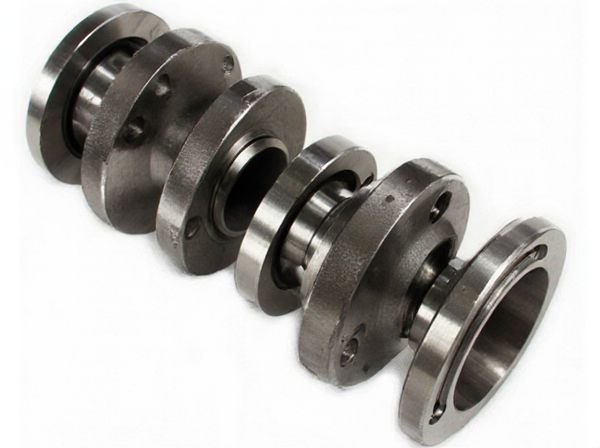
Photo illustration: Single Overhead vs Double Overhead Camshaft
The single overhead camshaft (SOHC) design features one camshaft per cylinder bank, controlling both intake and exhaust valves, which provides a simpler and more cost-effective engine configuration. Double overhead camshaft (DOHC) engines utilize two camshafts per cylinder bank, allowing more precise valve timing and improved performance, particularly at higher RPMs. Understanding the differences helps you choose the right engine type for your vehicle based on performance and efficiency needs.
Table of Comparison
| Feature | Single Overhead Camshaft (SOHC) | Double Overhead Camshaft (DOHC) |
|---|---|---|
| Camshaft Count | One camshaft per cylinder bank | Two camshafts per cylinder bank |
| Valve Operation | Operates both intake and exhaust valves | Separate camshafts for intake and exhaust valves |
| Valve Quantity | Typically supports 2 valves per cylinder | Supports 4 valves per cylinder for better airflow |
| Performance | Moderate performance and efficiency | Higher performance, improved power, and efficiency |
| Complexity & Cost | Simpler design, lower manufacturing cost | More complex, higher production cost |
| Common Usage | Economy and compact engines | Performance and high-output engines |
Introduction to Overhead Camshaft Designs
Overhead camshaft (OHC) designs, including Single Overhead Camshaft (SOHC) and Double Overhead Camshaft (DOHC), play a crucial role in valve timing and engine efficiency. SOHC engines utilize one camshaft per cylinder bank to operate both intake and exhaust valves, offering simpler mechanics and lighter weight. DOHC designs feature two camshafts per cylinder bank, allowing independent control of intake and exhaust valves, which enhances performance and higher rpm capabilities.
What is a Single Overhead Camshaft (SOHC)?
A Single Overhead Camshaft (SOHC) engine features one camshaft positioned above the cylinder head, directly operating both intake and exhaust valves. This design improves valve timing accuracy and reduces engine weight compared to older pushrod systems while maintaining simpler construction than Double Overhead Camshaft (DOHC) engines. SOHC configurations are commonly found in small to mid-sized engines, balancing performance and manufacturing cost effectively.
What is a Double Overhead Camshaft (DOHC)?
A Double Overhead Camshaft (DOHC) engine features two camshafts per cylinder head, one controlling intake valves and the other controlling exhaust valves, enabling more precise valve timing and improved airflow. This configuration allows for higher engine speeds and better performance compared to Single Overhead Camshaft (SOHC) designs, which use one camshaft per cylinder head. DOHC systems are commonly found in modern high-performance and efficient vehicles due to their ability to optimize power output and fuel economy.
SOHC vs DOHC: Key Structural Differences
Single Overhead Camshaft (SOHC) engines utilize one camshaft per cylinder bank to control both intake and exhaust valves, simplifying the design and reducing manufacturing costs. Double Overhead Camshaft (DOHC) engines feature two camshafts per cylinder bank, allowing independent control of intake and exhaust valves, which enhances valve timing precision and improves engine performance. The DOHC configuration typically supports higher engine speeds and better airflow, making it preferable for high-performance applications, while SOHC balances efficiency and complexity for everyday use.
Performance Implications: SOHC vs DOHC
Single Overhead Camshaft (SOHC) engines offer simpler design and lower manufacturing costs but typically produce less power and lower high-RPM efficiency compared to Double Overhead Camshaft (DOHC) engines. DOHC configurations enable more precise valve timing, facilitate higher engine speeds, and support multiple valves per cylinder, resulting in improved airflow, increased horsepower, and enhanced overall performance. Performance-focused vehicles benefit from DOHC setups due to their greater flexibility in tuning and higher power output potential.
Fuel Efficiency Comparisons
Single Overhead Camshaft (SOHC) engines often achieve better fuel efficiency due to simpler valve timing mechanisms and reduced friction, optimizing air-fuel mixture intake. Double Overhead Camshaft (DOHC) designs provide more precise valve control, enhancing performance but potentially increasing fuel consumption under certain conditions. Studies indicate SOHC configurations typically deliver slightly higher miles per gallon (MPG) in everyday driving scenarios compared to DOHC systems.
Cost and Complexity Factors
Single Overhead Camshaft (SOHC) engines generally have lower manufacturing costs and reduced mechanical complexity due to having only one camshaft controlling both intake and exhaust valves. Double Overhead Camshaft (DOHC) designs use two camshafts per cylinder bank, increasing production expenses and structural complexity but allowing for better valve timing precision and higher engine performance. The simpler SOHC layout is preferred in cost-sensitive applications, while DOHC is favored in performance-oriented engines despite its higher cost and intricate assembly requirements.
Maintenance and Longevity
Single overhead camshaft (SOHC) engines generally require less maintenance due to fewer moving parts, resulting in lower chances of valve timing issues and simpler timing belt or chain replacements. Double overhead camshaft (DOHC) systems offer improved engine performance but often demand more frequent inspections and adjustments to maintain optimal timing, especially for high-revving applications. SOHC engines typically exhibit greater longevity because of their simpler design, whereas DOHC engines may experience increased wear over time due to the complexity of dual camshafts and added components.
Applications in Modern Vehicles
Single Overhead Camshaft (SOHC) engines are commonly found in economy cars and motorcycles due to their simpler design and cost-effectiveness, providing adequate valve control for everyday driving conditions. Double Overhead Camshaft (DOHC) configurations dominate performance-oriented and luxury vehicles, enabling precise valve timing and higher RPMs that improve power output and fuel efficiency in modern hybrids and sports cars. The DOHC setup supports advanced technologies such as variable valve timing and direct injection, making it the preferred choice for automakers aiming to meet stringent emissions and performance standards.
Which Camshaft Setup is Right for You?
Choosing between a Single Overhead Camshaft (SOHC) and a Double Overhead Camshaft (DOHC) depends on your engine performance needs and maintenance preferences. SOHC offers simplicity and lower production costs, making it suitable for vehicles prioritizing fuel efficiency and ease of repair. DOHC provides better airflow and higher RPM potential, ideal for high-performance engines seeking increased power and precision valve timing.
 caratoz.com
caratoz.com